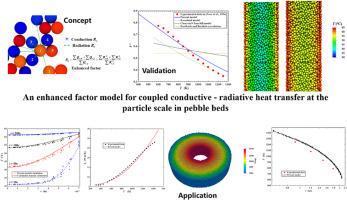卵石层颗粒尺度上传导-辐射耦合传热的增强因子模型
IF 3.2
3区 工程技术
Q1 NUCLEAR SCIENCE & TECHNOLOGY
引用次数: 0
摘要
在核球床中,传热是一个复杂的物理过程,涉及三个主要机制:颗粒-颗粒传导、通过接触对之间的流体膜传导(颗粒-流体-颗粒传导)和颗粒-颗粒热辐射。增强因子模型是一种用于粒子尺度模拟的新方法,旨在有效地解决这些综合现象。该模型将热辐射的贡献直接纳入接触粒子的粒子传导方程中。这是通过使用泰勒多项式近似的增强因子来实现的。这种方法的一个关键优点是它能够绕过复杂和计算昂贵的程序,如热射线追踪的视点因子计算。这种效率与亚细胞辐射模型(SCM)的使用相结合,可以在大型卵石床中进行传导和辐射传热的颗粒级模拟。增强因子模型已通过实验数据进行了验证,显示出普遍的一致性,并证明了其作为分析这些复杂核系统传热的有效工具。本文章由计算机程序翻译,如有差异,请以英文原文为准。

An enhanced factor model for coupled conductive - radiative heat transfer at the particle scale in pebble beds
In nuclear pebble beds, heat transfer is a complex physical process involving three primary mechanisms: particle-particle conduction, conduction through the fluid film between contact pairs (particle-fluid-particle conduction), and particle-particle thermal radiation. The enhanced factor model, a novel approach for particle-scale simulations, was developed to efficiently address these combined phenomena. The model incorporates the contribution of thermal radiation directly into the particle conduction equation for contacting particles. This is achieved through an enhanced factor that is approximated using a Taylor polynomial. A key advantage of this method is its ability to bypass complex and computationally expensive procedures such as thermal ray tracing for view factor calculations. This efficiency, combined with the use of a sub-cell radiation model (SCM), allows for the performance of particle-scale simulations of conduction and radiation heat transfer in large-scale pebble beds. The enhanced factor model has been validated against experimental data, showing general agreement and demonstrating its effectiveness as a tool for analyzing heat transfer in these complex nuclear systems.
求助全文
通过发布文献求助,成功后即可免费获取论文全文。
去求助
来源期刊

Progress in Nuclear Energy
工程技术-核科学技术
CiteScore
5.30
自引率
14.80%
发文量
331
审稿时长
3.5 months
期刊介绍:
Progress in Nuclear Energy is an international review journal covering all aspects of nuclear science and engineering. In keeping with the maturity of nuclear power, articles on safety, siting and environmental problems are encouraged, as are those associated with economics and fuel management. However, basic physics and engineering will remain an important aspect of the editorial policy. Articles published are either of a review nature or present new material in more depth. They are aimed at researchers and technically-oriented managers working in the nuclear energy field.
Please note the following:
1) PNE seeks high quality research papers which are medium to long in length. Short research papers should be submitted to the journal Annals in Nuclear Energy.
2) PNE reserves the right to reject papers which are based solely on routine application of computer codes used to produce reactor designs or explain existing reactor phenomena. Such papers, although worthy, are best left as laboratory reports whereas Progress in Nuclear Energy seeks papers of originality, which are archival in nature, in the fields of mathematical and experimental nuclear technology, including fission, fusion (blanket physics, radiation damage), safety, materials aspects, economics, etc.
3) Review papers, which may occasionally be invited, are particularly sought by the journal in these fields.
 求助内容:
求助内容: 应助结果提醒方式:
应助结果提醒方式:


